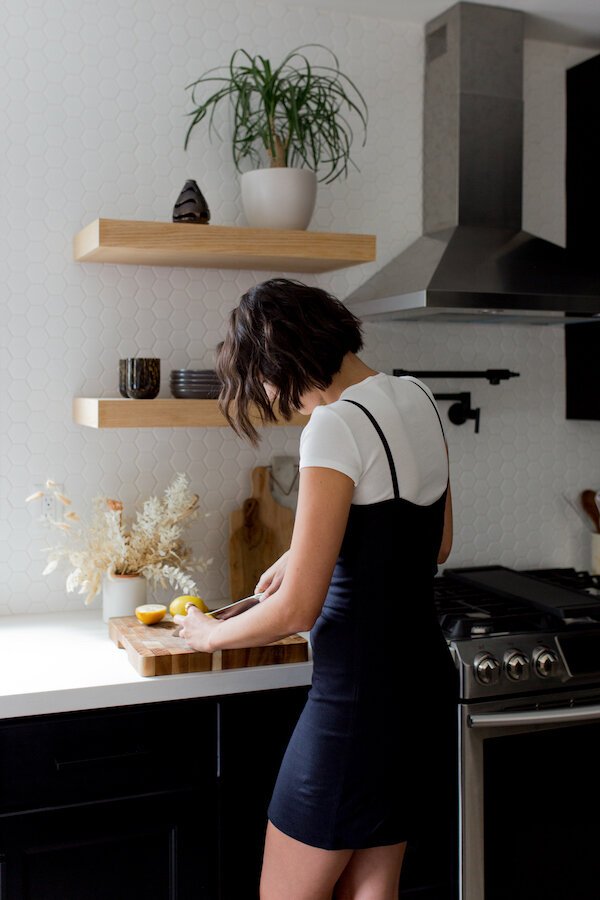
In Defense Of The House Dress
I’m wearing my house dress (again) today.
The dress itself is unremarkable: It’s a great triangle of grey linen that some tell me is green, although I can only ever see the color in a certain light. It came with a small tie belt, which I used to wear to preserve my waistline. Not anymore. I let it hang, embracing the potato sack look. 2020 turned us all—at least somewhat—into potatoes.
You may be asking, “Why not just opt for leggings?”
Some people are beautifully capable of frolicking through their to-do lists and work tasks wearing athleisure. I am not one of them. Even when I’m wearing schmancy organic cotton leggings, I find the compression and—ahem—breathability issues to be a major distraction. Who wants to peel clingy fabric from your legs, like you’re some sort of human banana, each time you have to go to the restroom? Not I. Somehow, even the horrors of stiff denim are more appealing than thin, sweat-inducing fabric stretched across my bum. It’s a personal preference, admittedly a strong one.
My appreciation for the house dress is quite new—when I was young, the media I consumed seemed to suggest that girls in dresses were not as strong as boys in pants. I always imagined it was as if the dress itself rendered its wearer incapable of the rigor—and the revolution—of pants (psst—see the history of men in skirts because it’s all just made up, anyway).
“I believed pants made me serious and competent, while dresses made me delicate and vulnerable—a misguided, gendered belief that it was the clothes that made me who I was.”
Because of this, I preferred pants and shorts for many years, resorting to dresses for special occasions. In cases like high school dances, I embraced the delight I found in dresses, and swung wildly in the direction of impracticality, opting for opulent discount-rack dresses that looked more like cupcakes than reasonable formalwear. I reserved the fun I felt in dresses for only rare, fleeting moments because I felt I’d only be taken seriously in pants. I believed pants made me serious and competent, while dresses made me delicate and vulnerable—a misguided, gendered belief that it was the clothes that made me who I was.
Dresses, I imagined, came with baggage. And they do. The garment is steeped in gender roles, shame, and archaic ideas of not what a woman could be but rather, what she should be.
Dictating how people should dress, especially women, comes from a Euro-centric view of what is “fashionable” and what is “acceptable.” Take, for example, the muumuu—which was introduced by colonists who called themselves missionaries to native Hawaiians as a way of dressing “modestly.” Similar patterns show up across other Pacific Islands.
“Dictating how people should dress, especially women, comes from a Euro-centric view of what is ‘fashionable’ and what is ‘acceptable.’”
“You need a dress that is dainty, neat, and pretty,” reads an American advertisement from 1940. And then there’s this guide to selling aprons and dresses, from 1925, which wastes no judgment in explaining why women want to wear fashion-forward house dresses: “Take the young bride, for example. She will doubtless be most interested in presenting as charming and dainty an appearance as possible.”
More recently, an email advertisement from Modcloth says the same thing, only in 2020 terms—their “easy on the eyes” house dresses “look just as good curled up on the couch as they do masked up in the grocery aisle.” Dainty. Charming. Easy on the eyes. But whose eyes, exactly, are we supposed to be going easy on?
As I matured and shed some of these expectations of having to be “ladylike” in dresses, I then discovered that dresses (especially ones with pockets) could be utilitarian. Groundbreaking, I know. So, during my ultra-minimalist phase, I got rid of all the frills that once thrilled me and settled on a single, uninspiring blue and grey-striped Kohl’s dress. It felt more efficient than a shirt and pants, and that, I thought, was all that mattered. While the efficiency worked for a little while, I soon found my once-vibrant personality turning blue and grey, too. It wasn’t the dress’s fault, but it felt symbolic. While golden sunlight streamed in through my windows, my bleak dress never saw the outdoors, never saw anything resembling physical exertion. And, embarrassingly, it rarely saw a laundry day.
“In my quest for a useful garment, I forgot that delight, too, was essential for me.”
It was more sustainable, sure, but is a deteriorating mental state truly sustainable? I became a sad potato in a sad potato sack, wearing what was easiest because my self-worth was faltering. In my quest for a useful garment, I forgot that delight, too, was essential for me. My recovery from that period included getting outside, getting some friends, and, eventually, getting rid of that dress. It felt like a rebirth, let me tell you.
Years later, in a twist that no one could have expected or ever wants to expect again, COVID asked me, “Hey do you want to wear something absurd?” And this time, I realized that I was ready to embrace both the usefulness and the delight of a house dress.
My linen dress gleamed like a gemstone from the back of my closet. There it was! I had what I needed all along.
And when I slipped on this new house dress, I realized how much a dress takes the shape of the person inside it. I could be demure, I could be demanding, I could be depressed. What really mattered was how I was dressing myself—am I pulling this dress on because it is comforting and invigorating, or am I pulling it on as self-punishment? The dresses decorating my body these days are ones that have seen coffee stains, grass stains, fur from my house rabbits, and flour from my baking habit. My dresses are a joyful canvas of a life that is really being lived.
“What’s truly flattering, anyway, is feeling good in what you wear.”
I’ve since added to the house dress collection: a too-long hot pink cotton maxi with ruffled sleeves, a spaghetti-strap slip made of bamboo lycra, a tiger-striped tee dress that, upon closer inspection, features strips of floral patterns worthy of grandma’s quilts. You’ll say that I’m wrong, but I secretly include an easy-on/easy-off soft denim jumpsuit in my list of “house dresses.” The matronly-apronly house dress has evolved, for me, into livable pieces that make me laugh and allow me to sit rather un-ladylike in my chair during Zoom calls. And forget “flattering,” I want roomy and flowy and free. (What’s truly flattering, anyway, is feeling good in what you wear).
In the face of expectation, I’ve settled on a new standard of what it means to dress for myself. The house dress is versatile and sometimes a little absurd; it helps me call on the strength that lies in self-expression. As I write this, my cozy dress has comforted me in the face of even more bad news. And tonight, I’ll unsheath from my daytime dress to my nighttime slip—maybe even before 6 PM, if I’m feeling generous towards myself. Which, these days, I am trying to do more often.
Maybe you’re saying I feel all of this, but for sweatpants. The truth is, our house uniform, whether it’s a dress or not, is about how we continue to show up for ourselves in the face of grief and anxiety. Are we still adorning ourselves, being soft with our bodies, and creating space for growth?
For me, in an era that seems to rob us of our humanity, the glimpses of the long-healed playground scars on my knees remind me how my body has made it through all these years. The pockets remind me that I have a deep well of support to draw from. And the twirl-able skirt reminds me I can always do a little shimmy and shake—that there’s still a precious handful of things to smile about.
“Our house uniform, whether it’s a dress or not, is about how we continue to show up for ourselves in the face of grief and anxiety.”
RELATED READING
Emily Torres is the Managing Editor at The Good Trade. She’s a Los Angeles transplant who was born and raised in Indiana, where she studied Creative Writing and Business at Indiana University. You can usually find her reading or writing, caring for her rabbits, or practicing at the yoga studio. Say hi on Instagram!

